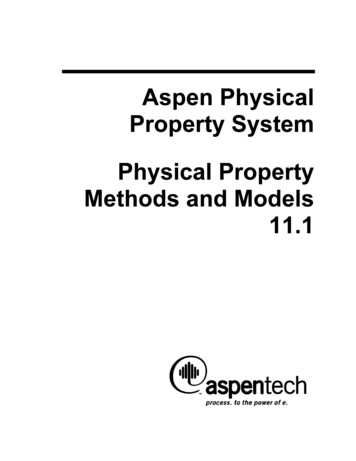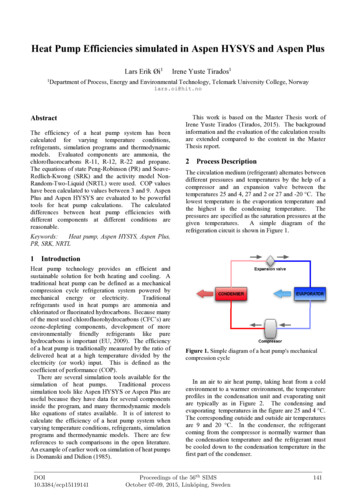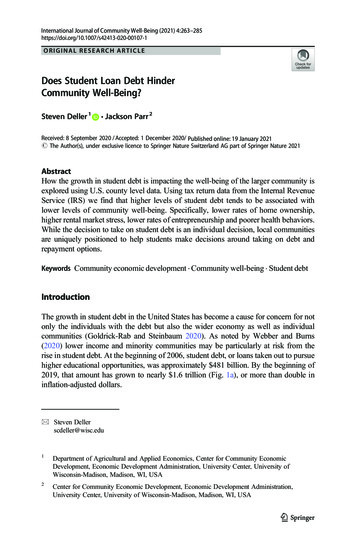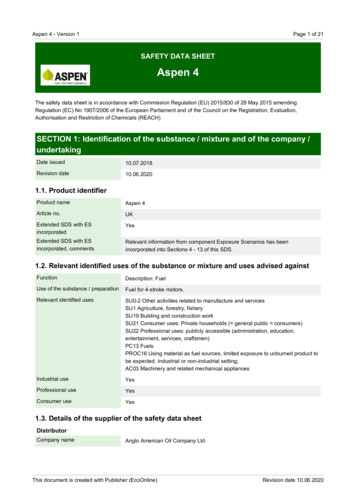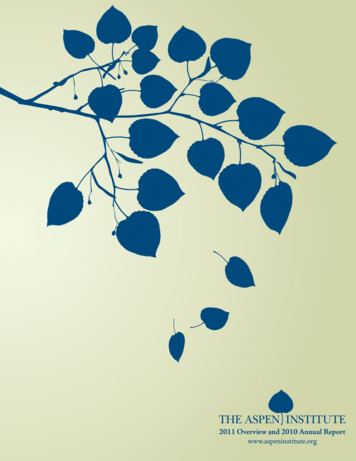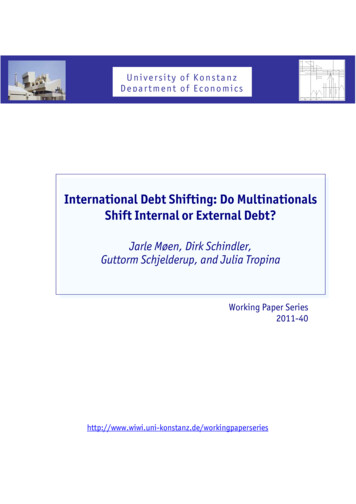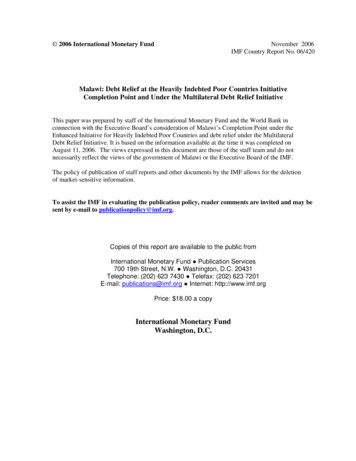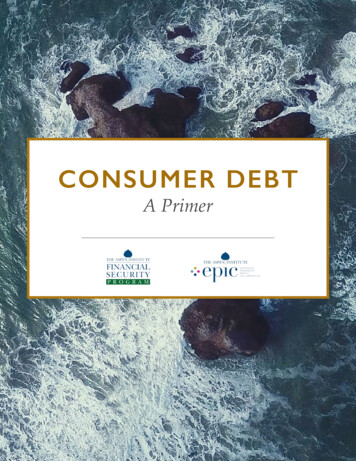
Transcription
CONSUMER DEBTA PrimerCONSUMER DEBT: A PRIMER1
CONSUMER DEBT: A PRIMERTHE EPIC CONSUMER DEBT INITIATIVEThe Aspen Institute’s Expanding Prosperity Impact Collaborative (EPIC)is a first-of-its-kind initiative in the field of consumer finance, designedto harness the knowledge of a wide cross-section of experts workingin applied, academic, government, and industry settings toward the goalof illuminating and solving critical dimensions of household financialinsecurity.As part of Aspen’s Financial Security Program (FSP), EPIC deeplyexplores one issue at a time, focusing on challenges that are critical toAmericans’ financial security but under-recognized or poorly understood. EPIC uses an interdisciplinary approach designed to uncovernew, unconventional ways of understanding the issue and build consensus among decisionmakers and influencers representing a widevariety of sectors and industries. The ultimate goal of EPIC is to generate deeply informed analyses and forecasts that help stakeholders (1)understand and prioritize critical financial security issues, and (2) forgeconsensus and broad support to implement solutions that can improvethe financial lives of millions of people.CONSUMER DEBT: A PRIMER2
EPIC’s current issue is consumer debt, which includes unsecured debt, auto loans, student loans, and other forms ofnon-mortgage debt. The time is ripe for an in-depth examination of this issue because the U.S. has recently reached recordhigh levels of outstanding credit card, auto loan, and studentloan debt, while mortgage balances remain slightly below 2008levels, raising critical questions about what this means for U.S.households’ financial security. Since consumer debt began torebound from the Great Recession, aggregate balances haverisen rapidly, with particularly large growth in educationand auto loans. During this time, wages have grown moreslowly. While delinquency rates for credit card and mortgagedebt are below their historical averages, default is an increasingly serious problem in the student and auto loan markets.Additionally, debt in collections appears on one-third of allconsumer credit reports. While many borrowers appear to bedoing well, there are indications that consumer debt poseswidespread challenges to financial security, especially forlow- and moderate-income households and other financiallyvulnerable populations.This is the right moment tobetter understand the changingdynamics of consumer debt,how households are managingthe debt they are carrying, andthe conditions under which it isa source of financial insecurity. Accelerator: During the accelerator phase, EPIC willengage in activities to ensure awareness, leadership, andaction-taking around consumer debt solutions. Over time,the accelerator functions will lead to long-term engagement of a diverse cross-sector group of strategic partnersand adoption of EPIC solution ideas by decision-makersand influencers.This report is a key first step in EPIC’s learning and discoveryphase. In addition to conducting this research synthesis, we aresurveying experts, convening leaders, and learning from consumers. This will help us better understand the specific aspectsof debt that contribute most to financial insecurity, as well asidentify ways to increase the priority of the issue among keystakeholders.This research primer sheds light on the meaning of currenttrends in consumer debt. It investigates the drivers, features,and consequences of consumer debt through a comprehensivereview of the existing literature. The primer considers various frameworks for studying debt, drawing from the fields ofeconomics, business, sociology, and consumer behavior. It analyzes historical patterns, contemporary drivers, and differencesamong demographic groups, as well as connections betweenspecific types of debt and financial distress. Importantly, theprimer also identifies critical gaps in the research and unanswered questions about the conditions under which consumerdebt becomes a source of financial insecurity, and who faces thegreatest risks. This investigation, as well as our other learningand discovery activities, will prepare us to prioritize problemsand articulate a framework for developing solutions in the nextphase of the EPIC process.EPIC’s work on consumer debt will take place through athree-phase process of learning and discovery, solutions development, and acceleration: Learning and discovery: During the learning and discovery phase, EPIC will synthesize data, poll consumers,survey experts, publish reports, and convene leaders, tobuild a more accurate understanding of how consumerdebt impacts low- and moderate-income families and howto identify a constellation of solutions to solve for it. Solutions development: During the solutions development phase, EPIC will develop a framework for evaluatingpotential solutions, select a set of highly promising solutions to explore in depth, vet those solutions with a diversegroup of consumers, cross-sector leaders and experts, andpublish our findings and analyses.CONSUMER DEBT: A PRIMER3
EXECUTIVE SUMMARYThe Aspen Institute’s Expanding Prosperity ImpactCollaborative (EPIC)—an interdisciplinary approach to illuminating and addressing critical aspects of household financialinsecurity—is focusing on consumer debt. EPIC is studyingthis issue now because consumer debt has reached recordhighs amid an economy more robust than at any point sincethe end of the Great Recession. Unemployment is at historiclows and wages are up, leading to many rosy interpretations ofcurrent debt trends. Yet signs continue to point to the fragilityof many families’ finances, and households’ experiences withdebt in the current economy vary widely on demographic andgeographic lines. This is a critical moment to better understandthe changing dynamics of consumer debt, how households aremanaging the debt they are carrying, and the conditions underwhich it is a source of financial insecurity versus an opportunity for future mobility.EPIC’s particular focus is on non-mortgage consumer debt,such as loans to pay for college or to purchase a vehicle, moneyborrowed on credit cards, and non-loan debt (i.e. municipalfines and fees, medical debt, and unpaid bills). Non-mortgagedebt has not received the extensive attention given to housingborrowing, largely because the size of the mortgage market.However, housing debt is declining as a share of householddebt and current causes for concern—such as rising rate of serious delinquency in credit cards and the emergence of subprimeFigure I:auto loans—relate to other areas of the market. This primerdistills the research on consumer debt, from its drivers andits dimensions to its impacts on households and society as awhole. EPIC will use this critical knowledge base to articulatea framework for developing solutions to improve the financiallives of millions of Americans.Debt is complex, dynamic, and hasmany driversTraditional economic theory posits that households behaverationally in borrowing and managing their debt based on theirunderstanding of their future income. People tend to borrowheavily in young adulthood (when they have lower incomesbut high costs such as education and housing), continue to borrow but at a slower pace during middle age, and then slowlypay down debt through old age. Research confirms that age andlife stage do determine borrowing patterns, but the strengthof this relationship may now be changing along with household demographics and income dynamics. Moreover, accessto credit doesn’t depend on age and credit history alone; it isalso affected by macroeconomic conditions and demographiccharacteristics, especially race and ethnicity. Borrowing andaccumulation of debt are also influenced by sociological factors including consumerism. Consumption is a key elementof social identity, and people often support status-enhancingconsumption through borrowing. Powerful and unreliableAggregateNon-MortgageDebt byDebtType (TrillionsDollars)of Dollars)AggregateNon-Mortgageby Type of(Trillions4.543.532.521.510.50200320042005HE REVOLVINGCONSUMER DEBT: A PRIMER200620072008AUTO LOAN200920102011CREDIT CARD201220132014STUDENT LOAN201520162017OTHER4
social norms regarding “good” and “bad” debt also influencedecision making. Finally, cognitive biases, many of which arenot fully understood, affect people’s use of credit products andassessments of their affordability over time.Figure II: Changesin Compositionof debt,Changesin compositionof consumerConsumer Debt,2007–20162007–20162%Across America, consumer debt isrising, but there are large variationsamong demographic groups11%2%3%6%8%1%There are stark differences in the amount, characteristics, andcomposition of debt by race and ethnicity that lead to or reinforce adverse outcomes for people of color. Today’s differencesare rooted in historical exclusion and structural barriers, butongoing predatory and discriminatory lending practices alsoplay a role.CONSUMER DEBT: A PRIMER200774%Consumer debt is not spread equally. It varies by geography,age, income, and race. Most types of debt—though not creditcard debt—show geographic variation. The composition andamount of debt varies by age but these patterns are changing.For example, although being of traditional retired age is associated with lower debt levels, the share of retirees carrying debtis above the historical average. With regard to income, debtburden is highest for middle-income households; the pooresthouseholds have the lowest levels of debt, but their debt is disproportionately from credit cards, high-cost unsecured loans,and unpaid bills.While borrowing is the most conventional path to householddebt, families facing emergencies, income shocks, or a persistent inability to make ends meet can incur expenses thatpush them into debt without taking out a loan. They may evenbe unaware of this debt or its size until negative informationappears on a credit report or collection agencies call. Leadingsources of non-loan debt include:9%5%3%4%The long-term trend of rising household debt began in the1950s. Although the emergence of credit cards and other unsecured credit contributed, mortgages were the driving force.This reached a tipping point during the Great Recession, leading to a dramatic, nearly decade-long pullback in mortgageborrowing. Overall consumer debt, however, surpassed thelevels that preceded the Great Recession due to growth in student and auto loans. As a result, the composition of aggregateand household-level debt has shifted and become less consistently effective at supporting wealth-building.Non-loan debt has becomea significant contributor tofinancial insecurity for millions ofhouseholds3%201669%MortgageOther InstallmentLines of CreditCredit Card BalanceEducationOtherAuto Out-of-pocket medical costs, which can generate medicaldebt, can be a source of financial insecurity even at relatively low levels and for consumers with healthy credithistories and otherwise manageable debt burdens. Medicalexpense shocks are fairly common, and the protection ofhealth insurance is often insufficient with 20% of consumers having a medical collections tradeline on their creditreport.State and local government fines and fees, which governments have increasingly relied on to finance publicservices, a trend that has disproportionately impacted5
Table I:Median value of debt holdings by income, thousands of 2016 dollarsPercentile of incomeAny debtPrimarymortgageInstallmentloansCredit cardbalancesOther nonmortgage debtAll families60,000111,00017,0002,3008,000Less than ,00028,0006,00078,000Table II:Median value of debt holdings by race, thousands of 2016 dollarsAny debtPrimarymortgageInstallmentloansCredit cardbalancesOther nonmortgage debtAll families60,000111,00017,0002,3008,000White non-Hispanic74,100115,00017,0002,70010,500Black non-Hispanic31,40078,00019,0001,4003,400Hispanic or Latino30,00099,00015,8001,7002,000Other or Multiple Race56,600150,00016,3002,4008,200 communities of color. These debts can have cascadingnegative effects on family finances, as they lead to driver’s license suspensions, garnishment orders, and even jailsentences. A burgeoning source of harmful non-loan debtis fees resulting from lawsuits filed against consumers bydebt buyers, which are clogging state courts.Unpaid bills, which account for over one-third of all delinquent debt. In addition to medical debt, unpaid phone andutility bills in collections most frequently appear on creditreports. Getting behind on payments for these basic services often reflects underlying financial insecurity; havingthese overdue bills reported to credit bureaus and in collections strongly reinforces that insecurity.Consumer debt can create insecurity,reduce wealth, harm families, and mayslow the economyConsumer debt is often a positive force in people’s lives andsupports economic growth, but its negative impacts on households are serious, widespread, and inequitable. Consumer debtis most likely to cause financial distress when a householdhas a high debt burden, as measured both by the proportionof income used to service debt and their subjective perceptionof financial stress. Carrying too much debt can create a rapiddownward spiral that starts with higher debt servicing costsCONSUMER DEBT: A PRIMERand can lead to court judgments and garnishments of wages,tax refunds, and other payments. The ultimate negative consequence, bankruptcy, fails to deliver long-term relief to manyfilers. Debt can also curtail households’ ability to save andbuild wealth. The pathways through which credit and debtlead to mobility have become less reliable and are broken forsome borrowers. For example, today’s unprecedented levelof student loan debt has raised questions about the degreeto which the benefits outweigh the costs, especially giventheir role in reducing homeownership and entrenching racialwealth inequality. There are also negative household impactsnot reflected on balance sheets, including physical and mentalhealth challenges. It can affect personal relationships includingromantic partnerships and family formation. Those whose debtis a source of financial distress are most likely to experiencecorollary ill effects.There has been less attention to the macroeconomic impactsof non-mortgage consumer debt outside of the connectionbetween debt and debt-driven business cycles. The generalconsensus is that no other type of consumer debt shares thesystemic significance of mortgages, but that rising credit cardand auto default rates are cause for concern as they signalhouseholds’ financial strength. Increasingly, economists raisethe possibility that the negative relationship between student6
Composition of InstallmentDebt by RaceFIgure III:Hispanic or LatinoBlack Non-Hispanic4%7%42% 32%51%64% White Non-HispanicOther or Multiple Race11%18%44%34%38%EDUCATIONAUTO55%OTHER INSTALLMENTcredit to meet current consumption needs, particularlyamong low-and moderate-income householdsThe growth and composition of various types of non-loandebt, such as unpaid medical and other bills; governmentalfines and fees, and taxes; and the degree to which holdingand making payments on non-loan debts impacts the features, levels, and ability to repay consumers’ other debtsThe downstream impacts of consumer debt on personalhealth and wellbeing, family relationships, and childrenThe long-term household outcomes associated with student loan debt and macroeconomic implications of thoseoutcomesResearch into each of these questions should consider variations based on households’ demographic characteristics,including race and ethnicity, gender, and age. Deeper examinations of the role of race are particularly important, given theexisting evidence of disparities that disadvantage people ofcolor. Many of the most acute debt-related challenges cannot beresolved without considering and responding directly to racialinequities.Debt must be considered within thecontext of consumers’ livesdebt and homeownership could be a drag on economic growth.The inter-relationships of consumer debt and macroeconomicconditions deserve greater attention in the future.Much about the character, causes,and consequences of consumer debtremains to be exploredAlthough extensive research has already been completed onconsumer debt—including its character, causes, and consequences—much remains to be explored. Some of the gaps arealready identified in the literature. For example, there remainsa poor understanding of “tipping points” at which a household’s debt becomes more harmful than helpful (Emmons &Ricketts, 2017).The primer identifies a number questions that warrant furtherresearch. Critical issues include: How the composition of consumer debt holdings vary,change, and affect household solvency and financial stability over time The extent to which the first debts taken-on by consumersshape their individual debt profiles as they age The degree to which rising debt from credit cards, personalloans, and similar unsecured products reflects reliance onCONSUMER DEBT: A PRIMERThe most important theme that emerges from the research onconsumer debt is that context is critical. One reason it is so challenging to understand the role and characterize the impact ofconsumer debt in household finances is that the “goodness”or “badness” of any individual borrowing decision dependsnot only on the household’s cash flow, other obligations, andassets, but also on interactions among the different debts thatpeople carry and a multitude of other factors. Households’financial and family contexts change over time, sometimes suddenly, exacerbating consumers’ struggle to accurately assesswhether a particular debt will be affordable or help them reachtheir goals. And yet, while each family has its own context, debtis a shared experience that impacts virtually all households atsome point in their lives. The problems identified in this primerrequire solutions that are broad enough to meet the needs ofmillions of households, yet flexible enough that they increasefamilies’ ability to adapt available resources to fit the context ofthe rest of their lives.7
FIgure 1:Common Types of Consumer DebtLATE22%*student loans34%*auto loans44%*credit carddebt32%**Debt incollections* Data source 2016 Survey of Consumer Finances** Data source is Consumer Financial Protection BureauINTRODUCTIONConsumer debt results from a household borrowing moneyfrom an external party. This may be to buy something that isexpected to last a long time (such as a house) or pay off in thelong run (like a college education) which costs far more thanwhat one could pay outright, or expensive durable goods (suchas a car or furniture). It may be simply to pay for somethingneeded or wanted when there is not enough cash on hand (paying for groceries, or a splurge night out, using a credit card thatwill not be paid off at the end of the month). At times consumers incur debt without taking out a loan, such as when a utilitybill is not paid off, or an emergency room visit costs more thanwhat they can immediately afford.Being able to borrow requires a lender that reasonably expect tobe repaid. The lender may base the expectation on the borrower’s current or anticipated income and past payment record. Inthe case of secured debt, such as a mortgage or car loan, thelender underwrites based on the consumer’s income cash flow,may also factor in their right to seize and sell off property ifpayments are not made.This paper examines the drivers of consumer debt, the landscape of consumer debt today, and the impacts of consumerdebt on households and the economy as a whole. Mortgagesrepresent the bulk of household debt, play a unique role asthe primary driver of household wealth, and have an important impact on the economy. For those reasons, home loanshave been the subject of extensive research and analysis, whileCONSUMER DEBT: A PRIMERnon-mortgage debt has received considerably less attention.This report focuses specifically on non-mortgage debt, including student loans, vehicle loans, credit card debt, and non-loandebt, which represent an increasing share of aggregate consumer debt. This report examines the existing research onnon-mortgage consumer debt from a variety of disciplines andsectors, synthesizes major themes and findings, and identifiesareas where additional research is needed.EPIC is studying this issue now because consumer debt hasreached record highs amid an economy more robust than atany point since the end of the Great Recession. Unemploymentis at historic lows and wages are up, leading to many rosy interpretations of current debt trends. Yet signs continue to pointto the fragility of many families’ finances, and households’experiences with debt in the current economy vary widely ondemographic and geographic lines. This is a critical momentto better understand the changing dynamics of consumer debt,how households are managing the debt they are carrying, andthe conditions under which it is a source of financial insecurity.PART 1: DRIVERS OFCONSUMER DEBTDebt is complex and has many drivers, ranging from forcesas large as business cycles and inequality, down to households-level conditions including income sufficiency andfinancial decision-making. Part 1 of this report focuses on majoreconomic, cultural, and psychological drivers of consumer8
The traditional viewpoint among economists, business leaders,and many policymakers is that individuals and householdsbehave rationally in borrowing and managing their debt basedon their understanding of their future income. Borrowingenables purchases needed or wanted in the present, removingthe constraint of spending tied to current income alone. Twosimilar theories from the 1950s—the “life-cycle hypothesis”(Modigliani & Brumberg, 1954) and the “permanent incomehypothesis” (Friedman, 1957)—posit why and how householdssave and “dissave” (borrow) to smooth consumption. Appliedto consumer debt, these lifecycle concepts predict that peoplewill tend to borrow heavily in young adulthood (when lowerskills and inexperience generate less income but there are highcosts for goods such as education and housing), continue toborrow but at a slower pace during middle-age (as income andexpenses converge), and then slowly deleverage (pay downdebt) through old age.Economists exploring the implications of the lifecycle hypothesis have generated an extensive body of empirical research onthe influence of liquidity constraints and the role of borrowing on household spending. Some of this confirms what theorypredicts. For example, recent research relying on the oldestSurvey of Consumer Finances (SCF) data found that the debtexperiences of Americans born between 1915-1924 conformedto what the lifecycle model predicts: their total debt increasedup to age 45 then began falling (Kuhn, Schularick, & Steins,2017). Similarly, today’s consumers tend to have the highestcredit utilization rates in their 20s, while those nearing and pastretirement age use far smaller proportions of the credit available to them (Fulford & Schuh, 2015).But theory and evidence also diverge. A mounting body ofresearch indicates that the permanent income hypothesis andlifecycle model fail to explain key aspects of household savings, borrowing, and debt repayment (Deaton, 1986; Baker,2014). The data show complex dynamic behavior (Lambertini& Azariadis, 2009). For example, consumers tend to borrowand consume less early in life than predicted, while consumingmore and borrowing less than predicted in middle age (Li &Goodman, 2015). Older Americans are now also carrying debtlater in life, even into the fixed-income years of retirement (PewCharitable Trusts, 2015-A). The same study of early SCF datareferenced above reveals that those born just 30 years later,CONSUMER DEBT: A PRIMER40%35%UTILIZATION RATEThe lifecycle model of consumptionCreditUtilizationRatesby GenerationFIgure2: CreditUtilizationRatesby Generation30%25%20%15%10%5%0%Gen. ZMillenialsGen. XBoomersSilent Gen.U.S. AverageGENERATIONData source: Experian, State of Credit 2017FIgure Revolving3: RevolvingCreditLimitsGenerationCreditLimitsby byGeneration 12,000 10,000 8,000DOLLARSdebt, particularly how characteristics such as age, race, andincome affect how much and what types of debt individualconsumers and families accumulate. 6,000 4,000 2,000 0Gen. ZMillenialsGen. XBoomersSilent Gen. U.S. AverageGENERATIONData source: Experian, State of Credit 2017between 1945-1964, experienced rising debt-to-income ratios(DTI) as they aged (Kuhn, Schularick, & Steins, 2017). It is possible that demographic changes leave older models outdated,failing to account for factors such as later-in-life householdformation and increased numbers of multi-generationalhouseholds.The changing nature of the economy also challenges the lifecycle idea, calling into question its underlying assumptions aboutconsumers’ income. The model generally views income andother financial shocks as isolated events, but income volatilityhas been rising for decades and has become a chronic conditionfor many workers. In the real world, debt that is rational andreasonable when taken on may become unaffordable later dueto volatility shocks (Gathergood & Guttman-Kennedy, 2017).Many households experience a constant struggle to smoothconsumption (Seefeldt, 2015). Moreover, even as income hasbecome more volatile, it has also stagnated. Median lifetime9
incomes among men have actually declined—a trend that someeconomists predict will continue in the future (Guvenen, etal., 2017). While the life-cycle model remains a useful startingpoint, it is insufficient to explain the dynamics of consumerdebt observable today.Macroeconomic conditionsEconomists have also noted the role that business cycles andcredit supply play in consumer debt. The amount of creditlenders make available and amount of debt consumers take onshow large business cycle variation that is much larger thanthe cyclical shifts in income or consumption (Fulford & Schuh,2015). Expanded availability of credit during times of economicgrowth is associated with higher levels of consumer debt,and the reverse effect is present in recessionary times (Gross,Notowidigdo, & Wang, 2016). Additional research has foundthat credit utilization rates are relatively steady throughoutthe business cycle. Borrowers are extremely sensitive to creditlimits. When consumers gain access to additional credit, theyincrease their debt proportionally; when their available creditshrinks they reduce their debt in a similar fashion (Fulford &Schuh, 2015).Large majorities of Americansconsider debt a necessity intheir own lives (69%) andsimultaneously see it as a toolothers generally use to livebeyond their means (85%)Since the Great Recession, increases in the costs of healthcare,housing, and food have been significantly larger than increasesin nominal income (El Issa, 2016). Increases in the costs of homeownership (Hartman, 2017), rent (Harvard Joint Center forHousing Studies, 2017), medical care (Auerbach & Kellermann,2011), and higher education (U.S. Department of Labor, 2016-B)are particularly notable and difficult for the majority of households to avoid. Consumers increasingly rely on debt to meetcurrent consumption needs, potentially because householdsstruggle to cope with rising costs amid decades of stagnantincomes (Boshara, 2016). Over recent decades, financially-imperiled households have borrowed because they cannot makeends meet, and more secure households have borrowed tomaintain their standard of living (Boshara, 2016). Debt incurredfor current consumption is growing and can undermine financial security by crowding out savings and reducing disposableCONSUMER DEBT: A PRIMERincome. As income inequality has risen, so has consumptioninequality, meaning that debt is not fully filling the spendinggap (Mason, 2017).Access to creditResearch has found that the availability of credit is the drivingfactor of consumer debt in both the short and long term (Fulford& Schuh, 2015). Access to credit determines which, if any, creditproducts consumers are able to use, as well as the cost of borrowing. Access to credit itself depends on a variety of factors,some of which are directly related to the household’s financialposition, such as repayment history, while others are outsidethe household’s control, such as credit supply economy-wide.The primary determinant of access to credit are borrowers’financial characteristics and on history of using credit and paying down debt. Nearly all secured loans use income and assetinformation in underwriting. With unsecured credit, incomeand bank account ownership are frequently considered. Interms of borrower history, the amount and types of debt accumulated in the past and timeliness of payments are primarydeterminants of whether a lender is willing to extend credit.But an individual’s behavior is only one of many factors thatinfluence how much access to credit they have and at what cost.Access to credit is also related to demographic characteristics such as age, length of residency in the United States, andrace and ethnicity. Young adults and recent immigrants, forexample, are particularly likely to be reliant on higher-costalternatives or unable to access the credit they need becausethe number of years of data in a credit report is a major determinant of the credit score (Debbaut, Ghent, & Kudlyak, 2014).Race also has an impact: black and Latino consumers have persistently lower credit scores than white and Asian consumers(Federal Reserve, 2007). This applies to whole communitiesin addition to individual consumers. Within cities, predominantly white neighborhoods have significantly higher averagecredit scores than neighborhoods primarily home to people ofcolor (Ratclif
push them into debt without taking out a loan. They may even be unaware of this debt or its size until negative information appears on a credit report or collection agencies call. Leading sources of non-loan debt include: Figure ii: Changes in Composition of Consumer Debt, 2007-2016 Out-of-pocket medical costs, which can generate medical
